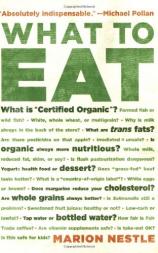Reading Group Guide
Discussion Questions
What to Eat: An Aisle-by-Aisle Guide to Savvy Food Choices and Good Eating

1. How have mealtimes and snacks changed since you were a child? Are your eating habits different from those of your parents? In what ways have they improved or gotten worse?
2. Did anything surprise you about what is involved in bringing foods to market and selling them? Did anything in what you read change your opinion about the role of food companies in government advice or action about food?
3. What were the most enlightening or reassuring facts you discovered in What to Eat?
4. Chapter five provides evidence that fresh fruits and vegetables are quite affordable, contradicting the frequent claim that Americans don’t eat enough fresh produce because it costs too much. How does this finding compare with your own experience? What do you think accounts for any differences you observe?
5. Did reading What to Eat change your understanding of the meaning of terms such as “organic” and “trans fat” and “natural”? What are your top priorities when making food choices? What are the best ways to determine whether certain foods really do meet your criteria?
6. In the introduction, Nestle writes, “The foods that sell best and bring in the most pro?ts are not necessarily the ones that are best for your health, and the conflict between health and business goals is at the root of public confusion about food choices.” Can you think of some examples from your own experience?
7. Did the book change your opinion about eating foods that have been genetically modified or irradiated? On what basis would you decide whether to eat foods treated in these ways?
8. Which weight-loss diets have any of your reading-group members tried? Did reading this book change your opinion of diets that eliminate a particular type of food (from no carbs to no sugar—not even in carrots)? Why do you suppose it is so difficult for many Americans to apply Nestle’s simple principle of “eat less, move more” when attempting to lose weight?
9. Discuss Nestle’s overall approach to the food dilemmas confronting us today (e.g., Is green tea really a wonder drug, or should we avoid the caffeine in tea and coffee? Are the omega-3 fats in fish worth the risk of methylmercury? etc.). What is the most reliable and rational way to resolve con?icting advice about food? Has reading this book changed the way you view the media’s “breakthrough” reports of new discoveries in nutrition?
10. What benefits and limitations does the book present about being vegetarian, vegan, or omnivorous? Did the book in any way affect your attitude about consuming dairy products, meat, or fish?
11. Nestle has been a vocal crusader against food marketing aimed at children, particularly for products that have a high sugar content. What can parents do to counter the effects of advertising and packaging on children’s food preferences? What is the best way to raise a child who eats healthfully and is eager to try new “adult” foods? Did reading this book make you curious about the quality of meals served in schools? What are the best ways to make school lunch programs more nutritious?
12. Do you routinely take nutritional supplements? If so, discuss which ones you take and why. Do you think they are effective? Explain how you know. Do you believe that new legislation is needed to reform the nutritional-supplement industry? If so, what types of rules would you want to see in place?
13. Does the success of publicly traded “organic food” corporations such as Whole Foods make you hopeful? Or must corporations always be at odds with healthful food choices and sustainable methods of food production?
14. What did you discover about frozen foods and packaged snacks? Can consumers balance the need for time management with foods that enhance long-term health?
15. Who should be responsible for ensuring that food is safe? You? Food companies? The government? What is the best defense against eating contaminated food? What is needed to prevent food safety problems such as those involving produce (spinach and lettuce in particular) as well as meat?
16. What sort of water do you usually drink—tap or bottled? What influences your decisions about beverages? What do you know about the quality of water in your community, and how could you find out more?
17. Do you believe that food choices are mostly a matter of personal responsibility? Or do you think that factors in the food environment—such as portion size, variety, and ubiquity—can in?uence what you eat?
18. Would you describe yourself as an optimist or a pessimist when it comes to eating well? What might need to happen to make you feel more optimistic?
19. Some readers have reacted to What to Eat by losing weight without even trying. What principles of weight loss does the book propose? What dietary changes might you make as a result of reading this book?
20. One of Nestle’s goals is to restore the joy of eating. Can American culture reconcile fears of food with the sheer pleasure of eating well?
What to Eat: An Aisle-by-Aisle Guide to Savvy Food Choices and Good Eating
- Publication Date: April 17, 2007
- Paperback: 624 pages
- Publisher: North Point Press
- ISBN-10: 0865477388
- ISBN-13: 9780865477384







